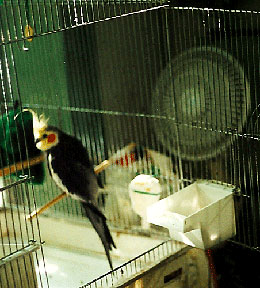Beyond Toys: Using Assistive Technology to Help
Your Bird Control His Environment
Jeanne Marie Shepard, MS, OTR/L
Reprinted from Companion Parrot Quarterly, formerly known as The Pet Bird Report,
Issue #53, Summer 2001.)
Giving Albert Control
Every morning, when "Mom" goes off to work, Albert the cockatiel surveys his activity options. He's got fresh food and water, of course, and a variety of perches to sit on, a bell to ring and a mirror to talk to. But these days Albert has a new, interactive toy, an electric fan that he can turn on and off as he pleases!
My work as an occupational therapist has exposed me to a wide range of assistive technology. Many devices have been developed to enable disabled people in controlling their environment by giving them control over electric and electronic equipment. Now birds can use this technology to control their environment as well.
The assistive devices consist mainly of switches that require a minimum of physical effort, strength, and coordination to manipulate. They include buttons to push, string switches to pull, levers that require only ounces of pressure to press or switches that can be pinched. When I worked in a special education classroom and saw what was available to my students I immediately imagined Albert learning to activate a switch.
One might ask, "Why teach a bird to activate a switch to operate an electric appliance or battery operated toy?" It is well documented that when humans feel they have some control over their environment, they have better mental and emotional health than those who do not feel they have control. The same is presumably true of other living creatures. A bird alone in a cage most of the day, even if he is provided with toys, has a relatively static environment; that is, there is little he can make happen. Imagine the same bird with switch options. He could turn on a radio or a tape player with his owner's voice. He could turn on a light, or even an electric fan, a slide projector or even a TV set. Assistive technology makes it possible for a bird to do many intricate, complicated and interesting things independently. And having the ability to make choices can decrease boredom, reduce frustration, and increase opportunities for intellectual exploration, which makes for a happier bird.
How to Do It
First, a switch that the bird can activate must be identified. I brought Albert with me to work at Fircrest School. Fircrest is a Washington state residential facility for clients who are severely physically handicapped and mentally retarded. Tim Cullinan, a Speech Pathologist and assistive technology expert, helped me evaluate Albert's switch operating abilities. First we tried a string pull switch, Albert played with it but did not pull down with enough force to activate it. Next, we tried a pinch switch since I know from experience that Albert can bite with considerable force, but he was more inclined to nibble the plastic coating off of it than to actually bite it.
Finally, we hit on a very logical choice for a bird; a perch that he could sit on. Under the perch (made from a piece of dowel) we attached a microlight lever switch. (These are available at Radio Shack and are very inexpensive.) Since this is a small, delicate switch we put some shrink coating on the ends to protect it. When Albert sat on the perch, the weight of his body depressed the perch/lever, which activated the switch.
The perch was installed in Albert's cage. This was done by sliding the perch/lever through the bars so that the switch and the wires were completely inaccessible to Albert and his busy beak. At first Albert was a little afraid of the perch/switch because it sank slightly under his weight and made a scary clicking sound. I desensitized him to it by hanging millet over it and soon, to Albert, it was just another piece of cage furniture.
Something Albert Would Enjoy
The next step was to find some device that Albert would enjoy activating via the perch/switch. It would have been easy to just plug the perch/switch into a battery operated toy that had been adapted for that purpose (and which are widely available in catalogs,) but I knew what Albert really loved was to have his feathers blown around by an electric fan. Some battery operated fans are available but they aren't very powerful. I found a 6-inch electric fan that clipped onto the file cabinet next to Albert's cage. To make this viable, I needed another piece of equipment to connect the electric fan to the perch/switch. The device I chose is called a Powerlink 3, made and distributed by Ablenet. The perch/switch and the fan are both plugged into the Powerlink 3. Then the Powerlink 3 is plugged into the wall outlet. The perch/switch now activates the fan. Now, whenever Albert sits on the perch/switch, he turns his fan on. When he gets tired of it, he gets off the perch/switch and the fan is turned off.

Frequently, when I get home from work these hot summer days, I find Albert sitting contentedly on his perch/switch, basking in the fan's breeze. He's learned that he can have his fan whenever he wants it. Any bird owner can make this happen for his or her pet. The technology is there and it is easy to use.
Bird owners who are interested in using assistive technology and who don't feel comfortable choosing equipment directly from catalogs should consult an occupational therapist, speech pathologist or special education teacher in their local school district. These professionals are trained in evaluating and setting up switch programs.
Resource
Ablenet: ablenetinc.com
Caution
Make sure parrot's beak can not come in contact with any of the electric wiring.